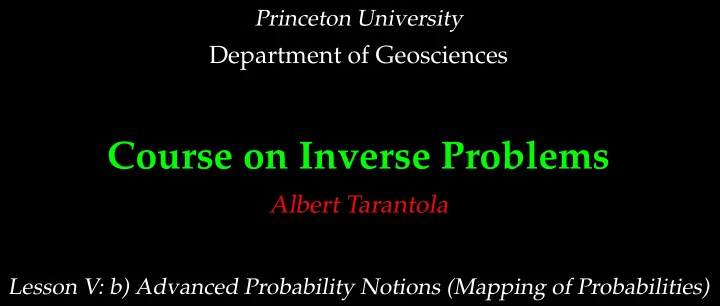

Princeton University Department of Geosciences Course on Inverse Problems Albert Tarantola Lesson V: b) Advanced Probability Notions (Mapping of Probabilities)
The following viewgraphs are a simplified version of my note http://arxiv.org/pdf/0810.4749 . This supplementary information is not an integral part of the course.
Radon-Nikodym theorem Assume given a measurable space ( Ω , F ) , and a measure µ on ( Ω , F ) that is σ -finite. Then, ( Ω , F , µ ) is called a σ -finite measure space. Let ν be a second measure on ( Ω , F ) . The fol- lowing assertions are equivalent (Radon-Nikodym theorem). • The measure ν is absolutely continuous with respect to µ . • There is a µ -almost everywhere unique function from Ω into [ 0, ∞ ) , denoted d ν / d µ , such that d ν � ν [ F ] = d µ d µ for every F ∈ F . F The function d ν / d µ is called the Radon-Nikodym density as- sociated with ν by µ . If a σ -finite measure µ is such that µ [ Ω ] = 1 , one says that µ is a probability measure , and the measure µ [ F ] of some set F ∈ F is then called the probability of the set F .
Intersection of measures Given a σ -finite measure space ( Ω , F , µ ) , consider two σ -finite measures ν 1 and ν 2 , that are absolutely continuous with re- spect to the base measure µ . Definition: The intersection of the two measures ν 1 and ν 2 , is the measure denoted ν 1 ∩ ν 2 whose Radon-Nikodym density is d ( ν 1 ∩ ν 2 ) = 1 d ν 1 d ν 2 . d µ n d µ d µ d ν 1 d ν 2 with n = � d µ d µ . Ω d µ
X intersection X X X
Reciprocal image of a measure Let ( X , E ) and ( Y , F ) be two measurable spaces, and ϕ : X �→ Y a measurable mapping. Two measures µ and ν are introduced (to be considered as base measures) such that ( X , E , µ ) and ( Y , F , ν ) are σ -finite measure spaces. Definition: To every measure τ on ( Y , F ) that is absolutely con- tinuous with respect to ν , is associated a measure on ( X , E ) , called the reciprocal image of τ , denoted ϕ - 1 [ τ ] , and defined via d ( ϕ - 1 [ τ ]) = 1 � d τ � d ν ◦ ϕ , d µ n with n = � d τ d ν ◦ ϕ d µ . X
Image of a measure Let ( X , E ) and ( Y , F ) be two measurable spaces, and ϕ : X �→ Y a measurable mapping. Definition: To every measure π on ( X , E ) , is associated a mea- sure on ( Y , F ) , denoted ϕ [ π ] , called the image measure : ϕ [ π ] = π ◦ ϕ - 1 , i.e., explicitly, ( ϕ [ π ])[ F ] = π [ ϕ - 1 [ F ] ] for every F ∈ F . Comment: To have an intuitive idea of the notion “image of a measure”, consider a collection of elements x 1 , x 2 , x 3 , . . . of X that are independent sample elements of the measure π . Then, it is easy to see that the elements ϕ ( x 1 ) , ϕ ( x 2 ) , ϕ ( x 3 ) , . . . of Y are independent sample elements of the measure ϕ [ π ] . In fact, this property alone may suggest introducing the notion of an image of a measure.
Compatibility property Let ( X , E , µ ) and ( Y , F , ν ) be two σ -finite measure spaces, and ϕ : X �→ Y be a measurable mapping. Let π be a measure over ( X , E ) that is σ -finite, and τ a measure over ( Y , F ) , that is absolutely continuous with respect to the base measure ν . Theorem: One always has π ′ = ϕ - 1 [ τ ] � ϕ [ π ∩ π ′ ] = τ ′ ∩ τ where τ ′ = ϕ [ π ] .
X Y
X Y -1 i i X Y
intersection X X X i -1 i Y Y Y intersection
intersection X X X image i -1 i Y Y Y intersection
intersection X X X image i -1 i Y Y Y intersection
Recommend
More recommend